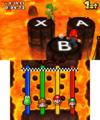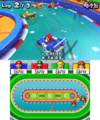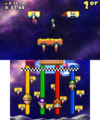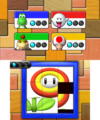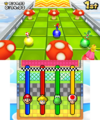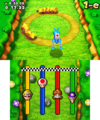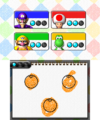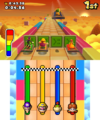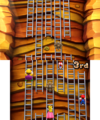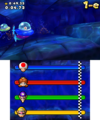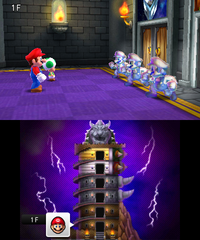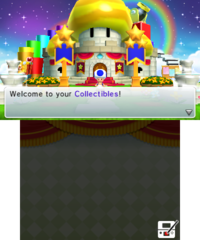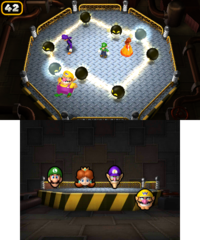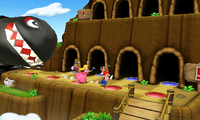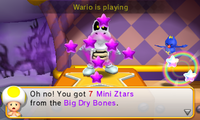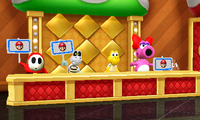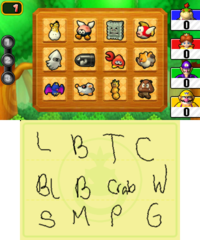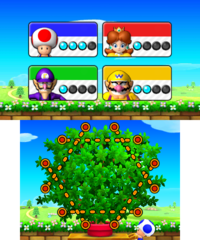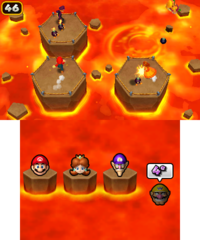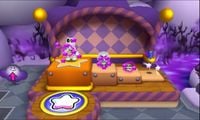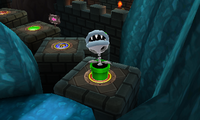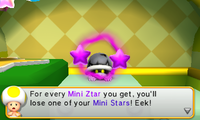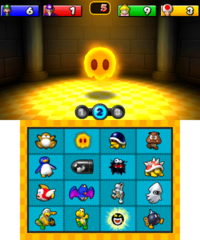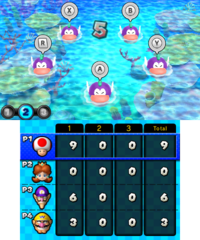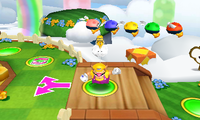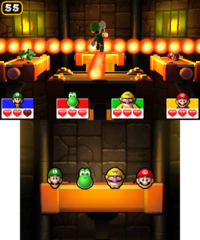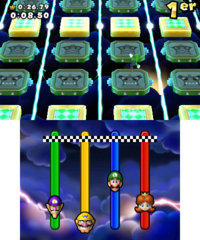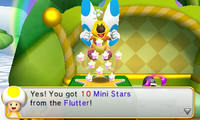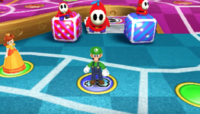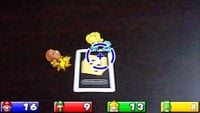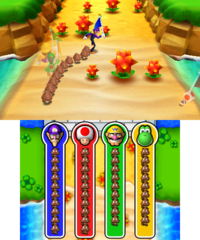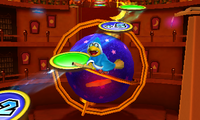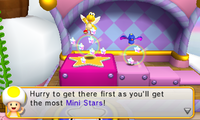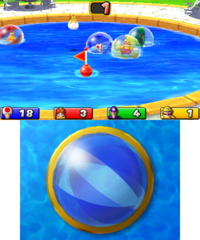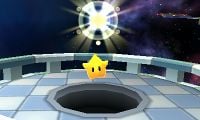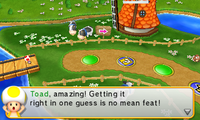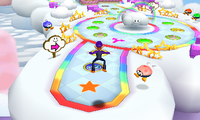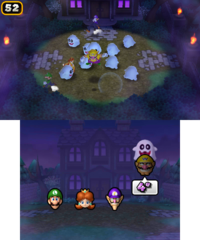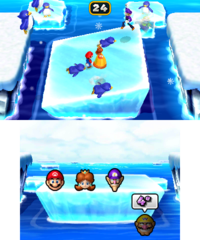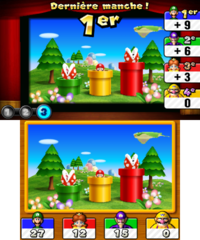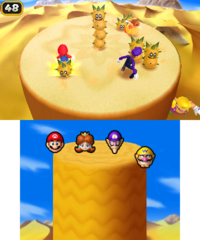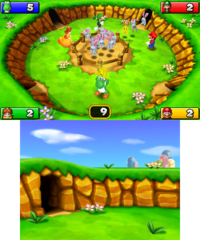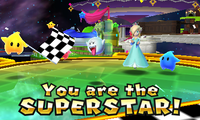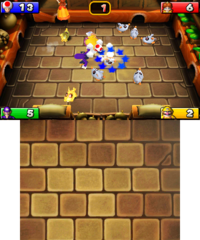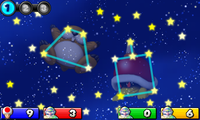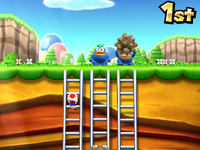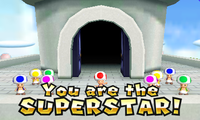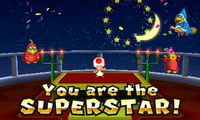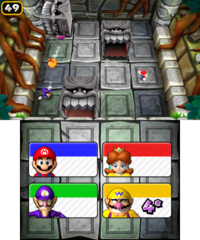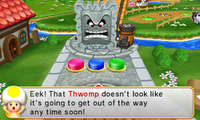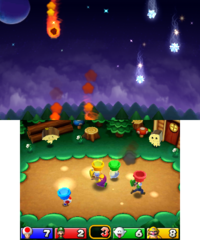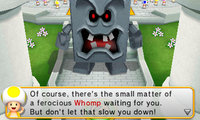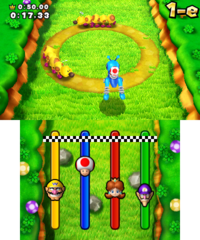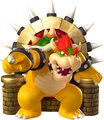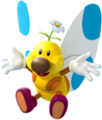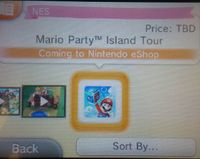Mario Party: Island Tour
Template:Infobox Mario Party: Island Tour is a game for the Nintendo 3DS, released first in the Americas in November 22, 2013, and the second Mario Party game to be developed by Nd Cube. It is the twelfth main installment (nineteenth overall) in the Mario Party series, the third installment for a handheld console, and the first Mario Party to be developed for the Nintendo 3DS. Mario Party: Island Tour has gameplay objectives unique to it compared to other entries in the Mario Party series. Rather than traveling around a board to obtain the most quantity of a particular item, either separately or together on a vehicle, players need to race their opponents to the finish in a linear, one-way board, with certain objectives in the race differing depending on the board played on. The game additionally retains several key elements from other Mario Party titles — namely, obtaining and using items to gain an advantage over opponents, and playing a wide variety of minigames.
Due to the platform being the Nintendo 3DS, some of the minigames take advantage of the system's features, such as the stereoscopic 3D, gyroscope, mic, augmented reality (AR), and the touch screen. The game additionally uses StreetPass, where players can play minigames if their system has picked up signals from other Nintendo 3DS systems that also have the game and unlock special items from doing so. Up to four people can play together either with local multiplayer or Download Play using only one game cartridge, similar to how Mario Party DS and later Mario Party installments for the Nintendo 3DS handle multiplayer.
The game was eventually released as a Nintendo Selects title in multiple regions including the Americas, Europe, and Oceania, being one of the best-selling titles for the Nintendo 3DS.
Story
After a relaxing day around Peach's Castle, Mario and the gang notice a strange letter in a bubble saying they are happily invited to the Party Islands. The gang then cheers about it but then the letter suddenly traps the gang in bubbles to carry them though the sky to the Party Islands.
While Mario and the gang are partying and playing games, Bowser shows up, feeling jealous about why Mario and his friends are invited and he wasn't, so he builds Bowser's Tower, saying that anyone can join him at his evil party. He begins locking all the fun from the Party Islands in bubbles. He also puts evil magic in the bubbles made by the bubble machine to make bubble clones of the gang to guard the tower. The player's selected character and a green Toad advance up the tower and defeat the bubble clones as well as various bosses. After defeating Bowser in Bowser's Sky Scuffle, the player's character then defeats the Mario bubble clones guarding the bubble machine and then destroys the bubble machine with a ground pound. Shortly afterward, Bowser reappears and boots the player's character and the green Toad out of the tower, inviting them to challenge him any time and that he won't be done.
Gameplay
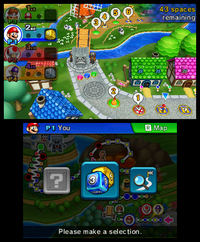
Unlike the direct preceding game, Mario Party 9, where all four players travel together through a vehicle and aim to obtain the most Mini Stars, Mario Party: Island Tour uses the traditional independent four-player gameplay as seen in previous Mario Party entries. The ultimate goal of the game in most of the boards is to race opponents on a linear-designed board to the finish line, unlike other Mario Party games, where players are required to amass the most amount of a certain item to win in all boards. In order to advance through the board, players roll a Dice Block numbered from 1 to 6 to dictate their movement. Each board has its own play style with different rules from another: one board, Star-Crossed Skyway, requires players to amass the most Mini Stars, while Kamek's Carpet Ride requires players to land exactly on a particular space, called a Just-Right Space, by using numbered cards. Another feature of these boards is to replace the "6" on the Dice Block with another feature, such as a Banzai Bill icon on Banzai Bill's Mad Mountain that causes players to fall back to the halfway point or the start of the board or a 0 in Rocket Road, meaning the player cannot move at all. Prior to starting out, a yellow Toad explains the board's play style, and after players are done viewing the rules, they roll a Dice Block to determine their turn order; players who roll a higher number than others will move earlier. In this game, a Round, similar to turns from earlier Mario Party titles, is taken once every player has rolled a Dice Block and moved accordingly, and while in earlier Mario Party titles had a limited amount of turns to take until the game ends, Mario Party: Island Tour proceeds until someone (or everyone, in the case of Star-Crossed Skyway) has reached the end goal. When starting their own round, players can either opt to use an item if an item is available for use or look around the map to plan out movement. If players end the game in a tie, a Dice Block roll determines who wins the game. At the end of the game, various stats are recorded such as how many spaces a player has landed on, a line graph depicting the players' progress, and other recordings depending on the board the players were playing on.
When players land on a Space, an event occurs depending on the type of space landed. Their function and design appears to be based off Mario Party 9; for example, if players land on a Green Space, nothing occurs while if a player lands on an Item Space on a specific type of board, they receive an item from a pool of randomized items. These items can either benefit the player directly or obstruct opponents. Players can carry up to two items, and players can use only one item per round. Only a few boards have an item system, however, and the type of items players receive varies on the board selected.
Some boards have players participating in minigames, either after every turn or if a Minigame Space is landed on. These minigames are small, short activities that have players competing against each other in defined, simple rules, most of them within a time limit. Some minigames involve players surviving a horde of enemies, some involve players racing against one another, some require the player to obtain the most points within a time limit, etc. If the player performs the best in the minigame, depending on the board played on, they receive priority when deciding which prize item to take or how much items are rewarded to them. The lower the rank players are, the lower the priority for selecting items and the less of a reward they receive, with last place players either receiving nothing or the worst rewards. If minigames end in a tie, a Dice Block is used to break the tie.
Mario Party: Island Tour supports local multiplayer if players have multiple cartridges or Download Play if there is only one cartridge. Up to four players can play the game, and they can participate with the player in Party Mode and Minigames Mode.
Modes
There are five different play modes in the game.
Party
Template:Quote2 Party Mode, hosted by a yellow Toad, is the main mode of Mario Party: Island Tour, which uses the default gameplay as described above. Up to four players can participate in this mode, and the mode allows a minimum of two players participating. Players first pick from a selection of available boards, all of which play differently from each other in terms of mechanics and goals. After that, players choose their character out of a cast of 10 playable characters, with 9 default characters and one unlockable. If there are not enough players, players can fill in empty slots with selected computer-controlled players from the remaining characters. Players can then select the difficulty of each individual CPU player, as well as the type of minigames that will be played with. Character settings are then saved the next time players access the mode, including those of CPU opponents.
Minigames
Template:Quote2 Hosted by a blue Toad, players can play in one of the many minigames in Mario Party: Island Tour through this mode. Unlike most Mario Party installments, all minigames are available from the start. Minigames Mode has three ways to play: Free Play, Time Attack, and Hot-Air Hijinks. Free Play allows up to four players to participate, and like Free Play from previous installments, players have a free choice to decide which minigame to play in. Once a minigame is played on, players have the option to play the minigame again, go to a randomly selected different minigame, go back to the minigame menu, or go back to the main menu. Time Attack is a single-player mode whose objective is to clear a set amount of ten minigames the quickest. Each minigame also contains optional objectives to meet if players want to further lessen the time it takes to complete them. Once all minigames are played on, the record time is saved. These are the minigames played in Time Attack:
The last mode is Hot-Air Hijinks (Balloon Race in British English), where up to four players can participate in. Players ride a hot air balloon, and in order to rise, they must clear minigames that are randomly selected through a roulette. For settings, players can use either All or Easy minigames and if their minigames require the Mic or not. Prior to starting out, players can set their objective to win 3, 5, or 7 minigames. If a player reaches past a certain level, the last place players get to stop the roulette wheel. Whichever player reaches the mark set first wins the mode.
StreetPass Minigames
Template:Quote2 StreetPass Minigames mode takes advantage of the Nintendo 3DS's StreetPass feature. Prior to setting up, players select their character to use in the mode and the choice to turn it on. If turned on, players who own Mario Party: Island Tour can pick up tags from other players who also own Mario Party: Island Tour and have it activated. When a tag is received, the Nintendo 3DS's LED light glows green, and a green dot notification is shown on the main menu on the StreetPass Minigames tab. When the mode is selected when a StreetPass tag is active, players see the other players' characters and their skill level, which dictates how difficult the CPU opponent controlling that character will be in the minigame. Players can participate against that character only once, unless the Nintendo 3DS is tagged with the same person the next day.
Bowser's Tower
- Main article: Bowser's Tower
Bowser's Tower is the sole single-player-focused mode of Mario Party: Island Tour and where the main story takes place. Players need to progress up a tower, and to progress, they need to win a gauntlet of minigames. Bowser's Tower contains 30 floors, where the opponents get progressively harder the more players progress up the tower. At every fifth floor, a boss-type minigame is played. A green Toad tags along with the player character on the way, and the player faces off against bubble clones, bubble copies of the playable characters. Players beat the game when they clear Bowser's Sky Scuffle, and they unlock Bowser Jr. as a playable character.
Collectables
- Main article: List of Mario Party: Island Tour collectables
Template:Quote2 Much like Mario Party DS and Mario Party 9, players can earn Mario Party Points by playing boards, completing Bowser's Tower, or playing Minigames. This points can be used to buy "Bubbles" and "Memories", respectively voice recordings or music from the various characters, boards, or minigames. These bubbles need to be bought from the gallery with various points, and not all bubbles are unlocked initially: the bubbles are unlocked when players first encounter them by simply playing the different modes and boards.
Characters
Playable
There are a total of 10 playable characters in Mario Party: Island Tour, consisting of 9 default characters and 1 unlockable character (Bowser Jr.).
| white | white | Peach | Daisy | white |
|---|---|---|---|---|

|
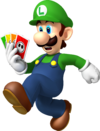
|
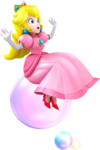
|
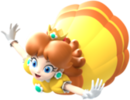
|
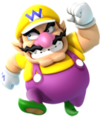
|
| The high-jumping hero wouldn't miss the party when his name is on the box. | Mario's lanky bro is always ready to roll. | She may be royalty, but this princess isn't above a minigame party. | Princess Peach's friend is no wallflower—she's in it to win it. | If you invite Wario to a party, you can be sure he’ll take things to extremes. |
| white | white | white | white | white* |
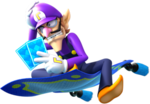
|
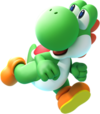
|
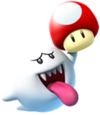
|

|
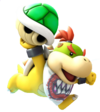 |
| He may not always be a people person, but Waluigi still loves a party. | Mario's green buddy is a good egg, so he's always invited to the party. | Add this gregarious ghost to the party to scare up some fun. | Loyal to a fault, Toad is ready to put friendship aside in the minigames. | He doesn't have his own tower, but you can't keep him from playing. |
*Bowser Jr. can be unlocked by completing Bowser's Tower.
Bosses
| Bosses and minigames | ||
|---|---|---|
Goomba Tower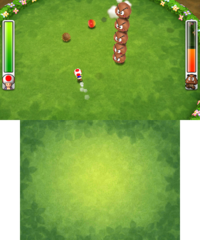
|
Chain Chomp
|
Mr. Blizzard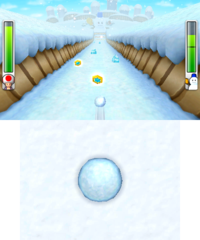
|
| Goomba Tower Takedown | Chain Chomp's Lava Lunge | Mr. Blizzard's Snow Slalom |
| Bosses and minigames | ||
King Bob-omb
|
Dry Bowser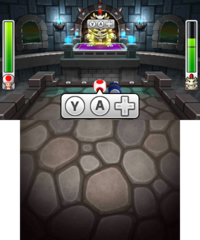
|
Bowser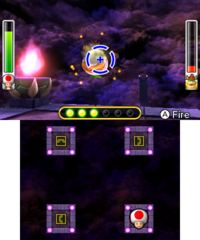
|
| King Bob-omb's Court of Chaos | Dry Bowser's Brain Bonk | Bowser's Sky Scuffle |
Other
Boards
As the title suggests, the boards are split between various themed islands. Seven gameboards are included in the game. Of these boards, one is unlocked by playing through every other board except for Shy Guy's Shuffle City due to the necessity for three or more players (Bowser's Peculiar Peak), and the other six are available from the start of the game. Names in italics indicate a British English name, if different from the American English name.
| Board | Description | Ratings | |
|---|---|---|---|
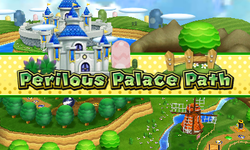 white |
American English: Power yourself up and knock opponents out of the way with special items as you race to the finish! British English: Race to the castle and use items to help you along the way! |
Play Time | 45-60 minutes |
| Skill | |||
| Luck | |||
| Minigames | |||
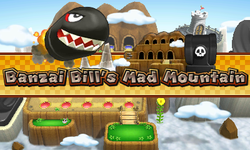 black |
American English: Should you go for the glory or hide out? Banzai Bill will test your luck and courage! British English: Climb the mountain but make sure not to get caught by Banzai Bill! This game is a test of courage! |
Play Time | 15-30 minutes |
| Skill | |||
| Luck | |||
| Minigames | |||
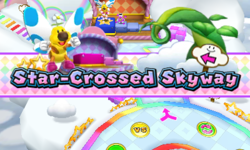 black |
American English: You will need the most Mini Stars to win this game—no matter how fast you finish! British English: Collect Mini Stars above the clouds! Timing is everything if you want to get ahead! |
Play Time | 30-50 minutes |
| Skill | |||
| Luck | |||
| Minigames | |||
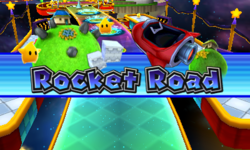 white |
American English: Blast yourself to the finish line by winning minigames and collecting Boosters! British English: Go rocket racing through outer space! Collect and use boosters to get to the goal the fastest! |
Play Time | 10-20 minutes |
| Skill | |||
| Luck | |||
| Minigames | |||
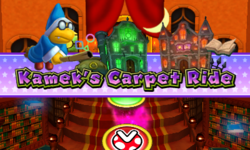 white |
American English: Play your cards right to be the first player to reach the goal! British English: Use cards to move around Kamek's mansion. Be sure to land exactly on the goal! |
Play Time | 20-40 minutes |
| Skill | |||
| Luck | |||
| Minigames | |||
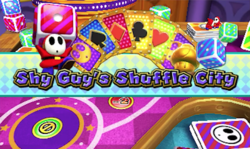 black |
American English: Outwit your opponents and avoid the dreaded Bowser Card to win this race! British English: Swap cards with your opponents for a card game with a twist. Don't be left with the Bowser Card! |
Play Time | 20-40 minutes |
| Skill | |||
| Luck | |||
| Minigames | |||
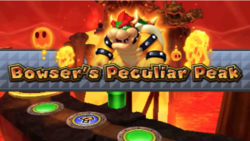 white Bowser's Bizarre Volcano |
American English: First place is the worst place in this reverse race. Bowser is waiting for the "winner"! British English: Whoever reaches the goal loses?! It's dangerous to move forward in Bowser's diabolical volcano! |
Play Time | 20-40 minutes |
| Skill | |||
| Luck | |||
| Minigames | |||
Spaces
| Space | Effect | Appears in... | ||||||
|---|---|---|---|---|---|---|---|---|
| Perilous Palace Path | Banzai Bill's Mad Mountain | Star-Crossed Skyway | Rocket Road | Kamek's Carpet Ride | Shy Guy's Shuffle City | Bowser's Peculiar Peak | ||
Back Space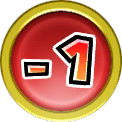 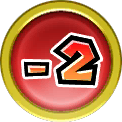 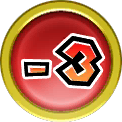 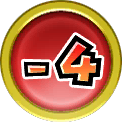
|
A space which will send you back (1, 2, 3, or 4) spaces. | |||||||
Banzai Bill Space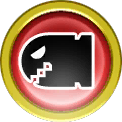
|
A space that launches Banzai Bill. | |||||||
Booster Space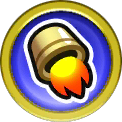
|
Land here to get one booster. | |||||||
Bowser Space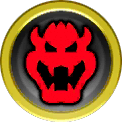
|
A space where something bad will happen! | |||||||
Challenge Area
|
You must stop here to face a challenge. | |||||||
Danger Space
|
Banzai Bill can hit you here. | |||||||
Dash Space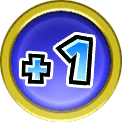 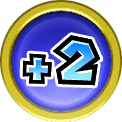 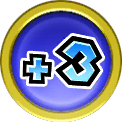 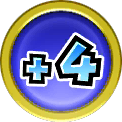 
|
A space which will let you advance (1, 2, 3, 4, or 5) spaces. | |||||||
Dead-End Space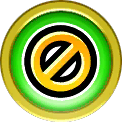
|
American English: You will be forced to stop on this space for an event. British English: You must stop on this space, where an event will happen. |
|||||||
Event Space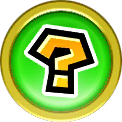
|
If you land here, a special event will occur. | |||||||
Free-for-All Space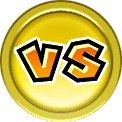
|
A space where you play a minigame to win an item. | |||||||
Goal Space
|
This is the finish line! | |||||||
Green Space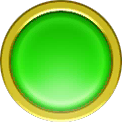
|
Nothing happens when you land here. | |||||||
Item Space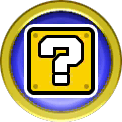
|
A space which will give you an item. | |||||||
| Just-Right Space (Just Right Space in the British English version) 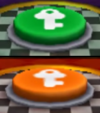
|
The way ahead will open when you land here. | |||||||
Kamek Space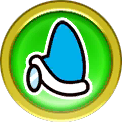
|
If you land on this space, Kamek will use magic to move everyone around. | |||||||
| Lucky Space (Event Space (blue) in the British English version) 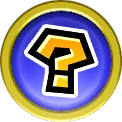
|
Land here and something good will happen. | |||||||
Piranha Plant Space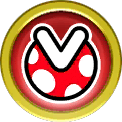
|
The Piranha Plant will throw you back a number of spaces. | |||||||
Safe Space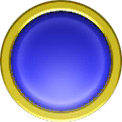
|
A space where Banzai Bill can't hit you. | |||||||
| Scramble Space (Switch Star Space in British English versions) 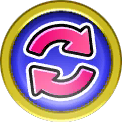
|
If you land on this space, you can rearrange the stars however you want. | |||||||
Star Stage Space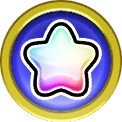
|
Land here to get Mini Stars or Mini Ztars. | |||||||
Switch Space
|
A switch that changes Banzai Bill's launch cannon. | |||||||
| Switch-Place Space (Front to Back Space in British English versions) 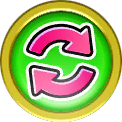
|
If you land here, the stars at the front will switch to the last position. | |||||||
| Unlucky Space (Event Space (red) in the British English version) 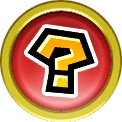
|
If you land here, something bad will happen. | |||||||
| Warp Space (Event Space in the British English version) 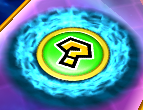
|
If you land here, a special event will occur. | |||||||
1 - As Extra-Move Spaces.
2 - The Switch Space subsequently becomes this after a player lands on it.
Items
Dice Blocks
Dice Blocks can be won from minigames in Perilous Palace Path and Bowser's Peculiar Peak.
| Item | Effect |
|---|---|
Gold Dice Block
|
Adds one to six spaces to the player's roll. Awarded to first place after a minigame. |
Silver Dice Block
|
Adds one to three spaces to the player's roll. Awarded to second place after a minigame. This is not given out if only two players are participating. |
Bronze Dice Block
|
Adds one or two spaces to the player's roll. Awarded to third place after a minigame (or second place, if only two players are participating). |
Custom Dice Block
|
Allows the player to roll any number. |
Bowser Dice Block
|
Same effects as a normal Dice Block. The players remain where they are if they get the roll doubled with another Bowser Dice Block. |
1-6 Bowser Dice Block
|
Adds one to six spaces to the player's roll. The players remain where they are if they get the roll doubled with another Bowser Dice Block. Awarded to fourth place after a minigame (third place if there are only three players, or second place if there are only two players). |
1-3 Bowser Dice Block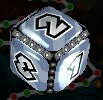
|
Adds one to three spaces to the player's roll. The players remain where they are if they get the roll doubled with another Bowser Dice Block. Awarded to third place after a minigame. This is not given out if there are only two players. |
1-2 Bowser Dice Block
|
Adds one or two spaces to the player's roll. The players remain where they are if they get the roll doubled with another Bowser Dice Block. Awarded to second place after a minigame, or first place if there are two or three players. |
Cards
In Kamek's Carpet Ride and Shy Guy's Shuffle City, cards are used to make the player move and have different effects on the character.
| Item | Effect |
|---|---|
Random Card  
|
Randomly decides how many spaces the player will move. |
Precision Card
|
Moves the player the number of spaces shown on the card. |
Power Precision Card 
|
Moves the user forwards by the number shown, while the others move backwards by the same amount. |
Bowser Card
|
The player who holds this card after three turns will receive a Bowser Penalty. |
Board-specific items
Perilous Palace Path
| Item | Description |
|---|---|
| Setback Shell |
Sends an opponent back two spaces. |
| Backwards Bill |
Sends an opponent back five spaces. |
| Blooper Chopper |
Halve the number your opponent rolls. |
| Lightning Score Striker |
Subtract 3 from your opponent's roll. |
Lakitu Leech
|
Take one random item from an opponent. |
| Dash Mushroom |
Add 3 to your dice roll. |
| Golden Dash Mushroom |
Add 5 to your dice roll. |
Super Star
|
Multiply your dice roll by 2. |
Crazy Kamek
|
Switch places with an opponent. |
Chaos Kamek
|
Switch everyone's places. |
Star-Crossed Skyway
| Item | Description |
|---|---|
Mini Star
|
Collect as many of these little twinkling stars as you can! |
Mini Ztar
|
These dangerous purple stars will lower your Mini Star total! |
Rocket Road
| Item | Description |
|---|---|
| Booster |
Use boosters to multiply the number you roll on the dice block. Each step will become a giant leap! |
Minigames
- Main article: List of Mario Party: Island Tour minigames
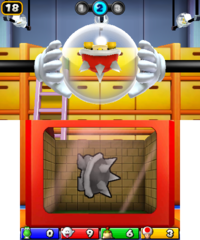
Mario Party: Island Tour contains 81 minigames, the most minigames for a handheld installment, barring the remastered minigames in Mario Party: The Top 100. Minigames are split into four categories: General minigames, Boss minigames, Puzzle minigames, and Extra minigames. General minigames play similarily to 4-player or Free-for-All minigames from previous installments: up to 4 players compete against one another to best the minigame, though players can compete against less players if they choose so. Boss minigames, first introduced in Mario Party 9, return in Mario Party: Island Tour. These involve players facing up against a particular boss enemy, and the objective is to take out the boss's HP first before they deplete the players' HP. Unlike their appearance in Mario Party 9, Boss minigames involve only one player. Puzzle minigames are self-explanatory: players solve minigames in a traditional puzzle game format either against themselves to set a new record or competitive against opponents. Finally, Extra minigames take advantage of the Nintendo 3DS hardware to play minigames, with The Choicest Voice using the mic and Ka-Goomba! and Sinking Feeling requiring AR Cards to play.
Minigames are sorted into two types of categories: minigames can be classified as "Easy", which are usually simpler minigames than the others. Players can toggle to play only "Easy" type minigames in Party Mode or Hot-Air Hijinks. Another type is whether the minigame uses a mic or not, and players can exclude the sole minigame that uses the mic, Utter Nonsense, from the set of minigames in the aforementioned modes.
Mario Party: Island Tour does not feature 2-vs-2, 1-vs-3, or 1-vs-Rivals minigames, making it one of the few Mario Party installments not to feature these categories of minigames. Additionally, this game is the only Mario Party game that has a minigame that cannot be accessed by a single player. In this case, the minigame Utter Nonsense requires two or more human players to play.
Regional differences
- Unlike any Mario Party game released before or since, with the exception of Mario Party 10, the game's descriptions for minigames, boards, and features, as well as the naming scheme for minigames, is different in British English than it is in American English. For example, Perilous Palace Path's description in the American English version reads as "Power yourself up and knock opponents out of the way with special items as you race to the finish!", while the British English version reads as "Race to the castle and use items to help you along the way!". Minigames can have drastically different titles; for example, a minigame named Garden of Eatin' in American English is called Blooming Nuisance in British English. In one case, a minigame's British title coincidentally shares its title with another unrelated, American minigame: Cheepers Keepers in American English refers to a button masher minigame, called Hook, Line and Cheep Cheep in the British English version of the game, while Cheepers Keepers in the British English version refers to a minigame counting diamonds in a Cheep Chomp's mouth, called Cheep Diamonds in the American English version of the game.
- The European Spanish announcer has a different voice actor than the Latin American Spanish announcer.
- The Dutch, European Portuguese, and Russian minigame announcers are female. All other language options have a male announcer.
Staff
- Main article: List of Mario Party: Island Tour staff
Mario Party: Island Tour was developed by Nd Cube and published by Nintendo. This is the second Mario Party game Nd Cube has worked on, after Mario Party 9, and the first handheld installment that they developed for. The game was directed by Yukio Umematsu, who would later work under planning for the next Mario Party installment, Mario Party 10. The game's sound was directed by Ichiro Shimakura, known for directing the sound in other Mario Party installments, while the soundtrack was directed by Rei Kondoh, who would later compose music for Mario Party 10.
Reception
Critical reception
Mario Party: Island Tour has received generally mixed reviews. The game currently averages a 59% based on 28 reviews on GameRankings[1] and a 57 based on 47 reviews on Metacritic[2]. As with most Mario Party games, Mario Party: Island Tour was praised for being fun to play with other people rather than playing alone and some of its mechanics were praised for being innovative, though general criticisms of the game include its short length, poorly implemented gimmicks, as well as the lack of online play.
Scott Thompson of IGN gave Mario Party: Island Tour a 5.5 out of 10, criticizing its motion control, "uninventive" minigames, and its "poor" single-player campaign unlike Mario Party 9, but praising its unique board rules and use of Download Play.[3] While expecting this game to perform around the same level as the console Mario Party games due to the inventive touchscreen implementation and unique, new rules for the seven game boards compared to previous Mario Party games, Thompson felt that the "lackluster single player experience", Bowser's Tower, was a slow-paced repetitive grind, and the "bland minigame design" was a step back, due to the similarity of the minigames from the past entries in the Mario Party series and the only category of minigames being Free-for-All type minigames. Caitlin Cooke of Destructoid gave the game a 4 out of 10,[4] disappointed that the game's board gameplay did not play as the original titles did and that the boards felt like chopped up variations of a single mode from previous Mario Party games. She additionally pointed out that the game has a too heavy hand with hand-holding players. She, however, enjoyed the single player mode of Bowser's Tower, the minigames, and the single-cartridge local mulitplayer, though criticized the lack of online play.
On the other hand, Kimberly Keller of Nintendo World Report gave the game the highest critic review, an 8.5 out of 10.[5] She has praised the innovation of the boards, which has each their unique play styles, the usage of the Nintendo 3DS capabilities in minigames, as well as noting that the single player modes Bowser's Tower, StreetPass Minigames, and Collectables being engaging, with Bowser's Tower being the best of the single player modes, though she had criticized the lack of setting a difficulty setting for Bowser's Tower. She also praised the Download Play multiplayer, though criticized the lack of online multiplayer.
| Reviews | |||
|---|---|---|---|
| Release | Reviewer, Publication | Score | Comment |
| Nintendo 3DS | Kimberly Keller, Nintendo World Report |
8.5/10 | "A fantastic addition for the 3DS. The graphics are crisp and utilize 3D well, while the music fits each game and board without becoming monotonous. Every mode and board is easy to pick up and play with anyone, anytime.. Island Tour is a perfect balance of old and new that keeps the game fresh with playing styles to meet every need." |
| Nintendo 3DS | Heidi Kemps, GameSpot | 7/10 | "It's not a perfect party by any means, but some good design considerations, better-than-average variety, and always-enjoyable Mario thematics put Mario Party: Island Tour a few notches above your average video game bash-in-a-box." |
| Nintendo 3DS | Dave Letcavage, Nintendo Life | 6/10 | "Those seeking a long-lasting single-player experience may want to steer clear though, as there isn't enough depth to the solo-focused modes to keep you engaged for very long." |
| Nintendo 3DS | Scott Thompson, IGN | 5.5/10 | "Island Tour’s single-player campaign is laughably bad, and the ambitious, content-rich multiplayer options and unique game boards are ultimately dragged down by mostly boring minigames and unfortunate system-jerking motion control." |
| Nintendo 3DS | Caitlin Cooke, Destructoid | 4/10 | "The lack of online play and the overall single-player experience is a pretty big bummer. Unless you’re desperate and need a quick Mario Party fix on the go, stick with a console version if you can." |
| Aggregators | |||
| Compiler | Platform / Score | ||
| Metacritic | 57 | ||
| GameRankings | 59% | ||
Sales
Mario Party: Island Tour is the 20th best selling game for the Nintendo 3DS, selling 1.14 million copies worldwide, as of March 31, 2014.[6] It has become a Nintendo Selects title in various regions, including North America, Europe, and Oceania.
Pre-release and unused content
Mario Party: Island Tour's changes from the pre-release version to the final version range from minor aesthetic details to gameplay tweaks. Perilous Palace Path originally did not contain Moo Moos as ambient characters or a Whomp blocking the path. Originally, characters also used cards rather than regular items in Perilous Palace Path. In Banzai Bill's Mad Mountain, multiple Banzai Bills could get launched at once as opposed to only one in the final version of the game. In Rocket Road, more varieties of Lumas were added rather than just one type of Luma, the Yellow Luma. The game was tentatively called simply Mario Party before the subtitle, Island Tour, was decided upon.
Glitches
Invisible Player Lucky Space Glitch
In order to perform this glitch, the player must land on a Lucky Space in the board Bowser's Peculiar Peak. If they happen to be blasted to a space that another player is currently on, then the two players clip through each other.
Gallery
- For this subject's image gallery, see Gallery:Mario Party: Island Tour.
Media
- For a complete list of media for this subject, see List of Mario Party: Island Tour media.
| File info 0:30 |
| File info 0:30 |
| File info 0:30 |
| File info 0:30 |
References to other games
- Super Mario Bros.: The main theme is rearranged in the minigames Xylophone Home and Goomba Tower Takedown. In Amp My Style, a rearrangement of the underground theme appears. In Perilous Palace Path, while in the Bowser Zone, a rearrangement of the castle theme appears. Also, the Starman theme is used for the Perilous Palace Path board whenever a player uses a Super Star.
- Super Mario Bros. 3: The song "Slowly Bubble Up" sounds similar to the Card Game/Spade Bonus music. Also, part of the athletic theme is remixed into "Hurry Up", one of the minigame themes.
- Super Mario 64 and Super Mario 64 DS: The "Koopa's Road" theme is rearranged for parts of Bowser's Peculiar Peak. King Bob-omb appears as a boss in this game as he did here, and Bowser makes a reference to his interest with his moustache from the remake saying, "My next guard has an even more formidable moustache than Mario!"
- Mario Party: Mario's artwork is based on his artwork from this game.
- Mario Party 6: Daisy and Waluigi's artworks are recycled from this game.
- Mario Party 7: Luigi and Boo's artworks are recycled from this game.
- New Super Mario Bros.: Dry Bowser returns with his ability to throw bones.
- Super Mario Galaxy: Rocket Road is based on this game, and Rosalina appears as a cameo along with the Lumas and the Comet Observatory. Additionally, the theme of Good Egg Galaxy is rearranged in a part of Rocket Road's music and Toad and Bowser Jr.'s artworks are recycled from this game.
- Mario Party DS: Wario's artwork is recycled from this game.
- New Super Mario Bros. Wii: Banzai Bill's Mad Mountain is based on World 6 from this game. Additionally, Peach's artwork is recycled from this game.
- Super Mario 3D Land: The minigame Blown Hover features Flip Panels and the square mountains from World 4-5 from this game. Also, Dry Bowser's voice clips are borrowed from this game. Para-Biddybuds also make some cameos. The background of Fuel Me Once is very similar to World 1-1.
- Mario Party 9: The voices of the characters and minigame announcer are borrowed from this game. Music such as the minigame intro and results screen are rearranged from this game. Mini Stars and Mini Ztars return in Star-Crossed Skyway.
- New Super Mario Bros. 2: Bone Goombas and Bone Piranha Plants return.
- New Super Mario Bros. U: Waddlewings make some cameos.
References in later games
- Super Mario Party: Bowser Jr.'s and Boo's victory and losing animations are recycled into this game.
Names in other languages
| Language | Name | Meaning | Notes |
|---|---|---|---|
| Japanese | マリオパーティアイランドツアー[?] Mario Pāti Airando Tsuā |
Mario Party: Island Tour | |
| Chinese (traditional) | 瑪利歐派對Island Tour[7] Mǎlì'ōu Pàiduì Island Tour |
Mario Party: Island Tour |
Trivia
- For a time, the Nintendo 3DS eShop mistakenly stated Mario Party: Island Tour to be a title on the Nintendo Entertainment System.
- A female announcer is used for minigames in the Dutch, Portuguese, and Russian versions, a practice that had not been seen in non-Japanese versions since Mario Party 5, and would not be seen again until Super Mario Party.
References
- ^ GameRankings score for Mario Party: Island Tour. GameRankings. Retrieved December 5, 2017.
- ^ Metacritic score for Mario Party: Island Tour. Metacritic. Retrieved December 5, 2017.
- ^ Thompson, Scott. (November 22, 2013) Mario Party: Island Tour Review. IGN. Retrieved December 5, 2017.
- ^ Cooke, Caitlin. (November 27, 2013). Review: Mario Party: Island Tour. Destructoid. Retrieved December 5, 2017.
- ^ Keller, Kimberly. (November 22, 2013). Mario Party: Island Tour Review Nintendo World Report. Retrieved December 5, 2017.
- ^ "Financial Results Briefing for Fiscal Year Ended March 2014 (Briefing Date: 5/8/2014) Supplementary Information". (May 8, 2014). Nintendo. Retrieved December 5, 2017.
- ^ Official Chinese website for the Super Mario Bros. 35th Anniversary. Retrieved October 23, 2020.

